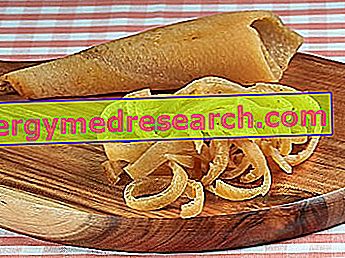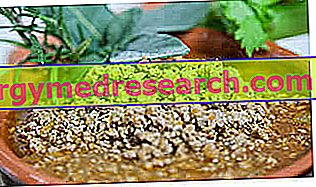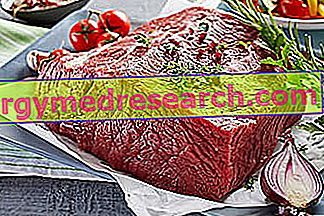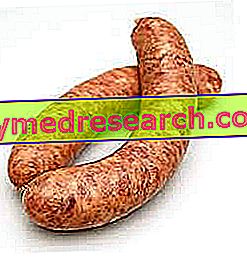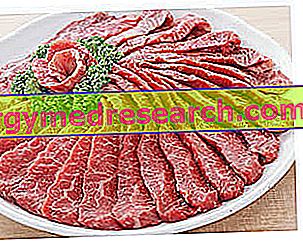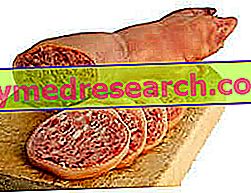What are What are pork rinds? The pork rinds, sometimes called rind, or rind - the most suitable term to mention the natural covering of the ham - are foods of animal origin that can be placed in the subset of the fifth quarter. Specifically, it is the pig's skin - Sus scrofa domesticus - properly shaved - deprived of the bristles - cleaned and reduced to pieces
Category meat
Etymology and History Porchetta derives from the Latin " porchetti ", in Italian "porchetto", or small pig. Disambiguation: the term porchetta is undoubtedly one of the most inflated substantives of Italian cuisine; in fact, at least 3 meanings can be associated with it: the first, to which we will refer in the next paragraphs, is used to name a young pig roast, gutted, boned, scraped by the hair, with the head, seasoned, impaled, tied (sewn) and cooked so as to give crispiness to the rind external; the second indicates the young specimen of Sus scrofa domesticus (pig); in f
Generality The ITALIAN quail is a bird commonly used for food purposes, both for its meat and for its eggs. It belongs to the Phasianidae family, Subfamily Perdicinae, Genus Coturnix , Species coturnix ; the binomial nomenclature of our local quail is Coturnix coturnix L. Note: for breeding we prefer the Coturnix japonica (as it is larger, therefore more profitable) or the fruit of the cross between it and the local Species
Generality Ragù is a sauce intended to accompany first courses based on: pasta (dry, fresh, stuffed), gnocchi or polenta; other recipes with ragù are the stuffed Sicilian arancini, the bruschette etc. Ragu means "generically" a food characterized by the presence of meat, fish or vegetarian substitutes (such as tofu or seitan) ground, blended with wine and prepared with long cooking times (with or without the addition of tomato).
What's this What is the rump? The rump is a cut of meat derived from beef - Genus Bos species taurus . Cattle breeds widely used to obtain the rump are: Chianina, Angus, Kobe and Wagyu. Despite being close, anatomically speaking, to the Florentine steak, the T-bone and the porterhouse, the rump is a different piece of meat in its own right
Generality Sausage is a preserved and preserved meat obtained mainly from pork / wild boar (especially Sus scrofa ). Its discovery is attributable to the Lucanian populations (before the birth of Christ); not by chance, the archaic nomenclature of the sausage corresponds to the noun of " lucanica"
What is game? Wild game (or game) means any animal hunted for food; it is also the generic name reserved for prey caught in the practice of sport hunting. The animal species that fall into the game group vary greatly depending on the area, and can be classified according to size and biological class
As for meat and derivatives, the choice is not difficult. Among the fresh, lean and low cholesterol products, the famous chicken and turkey meats stand out. The low calorie cuts are essentially made up of the skinless chest / topside (while the rest of the animal has a higher lipid percentage); it is however possible to follow some small rules that could reduce the costs of supplying these foods
What's this What is T-Bone? T-bone and porterhouse are two cuts of meat obtained from the back of the hind quarter of the beef (adult bovine, Family Bovidae, Genus Bos and species taurus ). Cattle breeds widely used to obtain t-bone are: Chianina, Angus, Kobe and Wagyu. Note : T-bone and porterhouse are NOT synonyms of Florentine steak - much thicker
What is Zampone? Zampone is a gastronomic preparation based on minced meat, fat and rind mixed with other ingredients such as salt and spices (similar to cotechino). As such, the zampone belongs to the group of foods and its chemical nutritional characteristics are distinguished by the contribution of: high biological value proteins, saturated fats, cholesterol, iron and predominantly water-soluble vitamins of group B
MEAT PROTEIN FAT TENDERNESS DIGESTIBILITY Lamb (lamb) 15-20% 3-8% very soft Discrete Agenellone 18-20% 3-5% very soft high Castrated / sheep 18-24% 5-10% Discrete Discrete Kid 18-20% 4-6% very soft Discrete Source. INRAN

